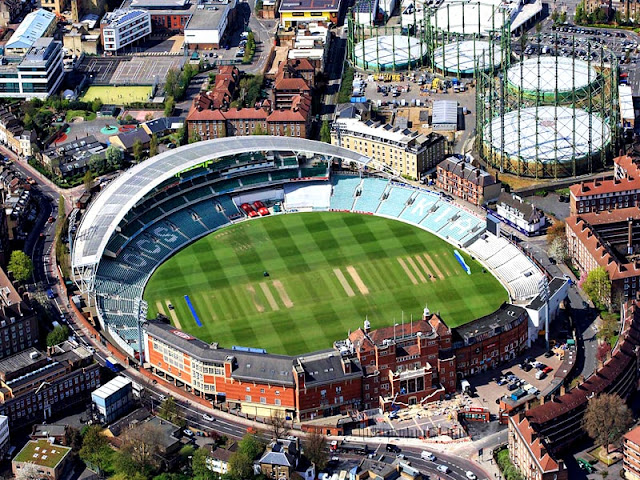Why is lord’s called “Home of Cricket”? – A Brief History of Lord’s Cricket Ground
Lord’s Cricket Ground located in St John’s Wood, London, England is the most prestigious cricket venue in the World. Lord’s Cricket Ground commonly known as Lord’s is named after its founder Thomas Lord. It is owned by Marylebone Cricket Club (MCC) and was the home of the International Cricket Council (ICC) until August 2005.
Its founder Thomas Lord (Born. November 23, 1755 – Died.
January 13, 1832) was a first-class cricketer from 1787 to 1802. Lord made a
total of 90 first-class outings throughout his career. As a ground staff
bowler, he was primarily connected with Middlesex and Marylebone Cricket Club
(MCC). Lord is well known for establishing Lord's Cricket Ground.
This venue is still considered the home of the England and
Wales Cricket Board (ECB), the European Cricket Council (ECC) and, Middlesex
County Club.
Lord’s has the world’s oldest sporting museum. Lord’s is
currently located on the third of three sites that its founder, Thomas Lord
developed between 1787 and 1814. Today known as Lord's Old Ground was originally
the Dorset Square, his first ground. His second ground was utilized from
1811 to 1813 before being abandoned for the Regent's Canal's construction
across its outfield. The current Lord's Ground lies about 250 yards (230
meters) northwest of the Middle Ground's location. This stadium has a seating
capacity of 30,000 people.
Early History
In 1813–14, Lord had a tavern built, followed by a wooden pavilion in 1814. The MCC first played first-class cricket on the current pitch in July 1814, against St John's Wood Cricket Club. Frederick Woodbridge (107) of Epsom scored the first century at the venue in first-class cricket against Middlesex, and Felix Ladbroke (116) of Epsom scored the second century in the same match. The annual Eton v Harrow match, which began in 1805 on the Old Ground, came back to its current location on July 29, 1818. Lord's has hosted the fixture almost every year since 1822. When William Ward scored 278 for the MCC against Norfolk in 1820, it was the first double-century in first-class cricket. The old pavilion, which had recently been restored at considerable expenditure, was destroyed by fire on July 23, 1823, following the inaugural Winchester v Harrow match, which lost virtually all of the MCC's and the wider game's historical records. Lord quickly reconstructed the pavilion. In 1825, Lord suggested expanding the area with homes at a period when St John's Wood was undergoing fast growth, putting the ground's future at risk. This was avoided by William Ward, who acquired the land from Lord for £5,000. Ward retained control of the land until 1835 when it was sold to James Dark. The pavilion was renovated in 1838, and gas lighting was installed. Lord's was still a rural ground during this period, with open countryside to the north and west.
The ground was continually improved, resulting in the installation of a
telegraph scoreboard in 1846. In 1848, a small chamber was constructed on the
pavilion's north side for professionals, with a separate entrance. During the
1884 Ashes, Lord's staged its first Test match, becoming England's third Test
venue after The Oval and Old Trafford. England dominantly won the game by an
innings and 5 runs. In 1909, England, Australia, and South Africa formed the
Imperial Cricket Conference (Now known as International Cricket Council), with
Lord's as its headquarters.
The Home of Cricket
Lord’s is also referred to as the “Home of Cricket” or “The
Mecca of Cricket” because of its historical significance in the world of
Cricket. It is the first ground ever to be built for cricket. The Lord's has a
tradition of acknowledging players who score a century or pick a fifer on their
honors board, and every player dreams of this accomplishment and which will
earn them a place in history. This venue has hosted Three (3) World Cup Finals.
The Pavilion: The terracotta-colored pavilion,
which was built in 1890 and is now one of the most recognized monuments in
international sport. The Warner Stand, which opened in 1958 and is named after
the renowned player and administrator Sir Pelham "Plum" Warner, is located
adjacent to the pavilion as you travel clockwise around the pitch.
The Main Grandstand: The main grandstand was
built in 1997 to replace Sir Herbert Baker's aesthetically distinctive
building, which opened in time for the 1926 Ashes Test. Baker gave MCC Father
Time, the weathervane that topped his masterpiece until 1996 when it was moved
to the opposite side of the ground.
The Nursery: The far end, known as the Nursery,
is surrounded by the Compton and Edrich Stands, a set of low-level two-tier
stands built-in 1990 that seem eerily identical to the ones they replaced
(which were known as the Free Seats on account of them being available to those
who had paid the basic ground admission - entry to other areas required extra
payment).
The Tavern: The Tavern (1967) is the least
notable of the stands, demonstrating the 1960s' basic function. Until the late
1980s, fans could watch the proceedings from the concourse in front of the
stand, but rising rowdiness put a stop to that. The former Tavern, an ivy-clad structure,
was well-liked by customers.
The Allen Stand: The Allen Stand (originally the
Q Stand) is the final stand before returning to the pavilion, a small in-fill
that acts as a pavilion overflow on big-match days and also as Middlesex's club
room sometimes.
It is this emotional significance and its rich history that
makes Lord’s a very special venue and almost every cricketer’s dream place to
prove themselves.






Comments
Post a Comment